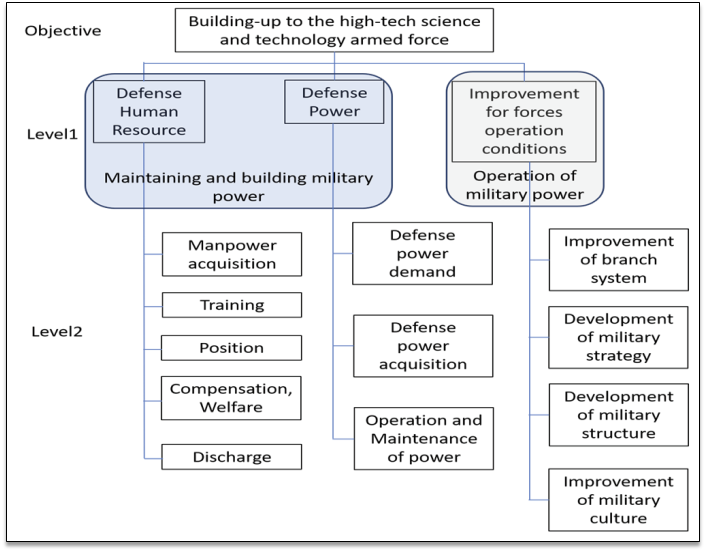Analysis of future defense policy priorities with AHP
DOI:
https://doi.org/10.37944/jams.v6i1.184Keywords:
high-tech science and technology armed force, defense policy, AHP analysis, priority of policy, weapon power required, excellent manpower acquisitioAbstract
Future defense systems cannot maintain the large-scale military force they currently have owing to population decline. Accordingly, the paradigm of military force construction and operation must change from being quantity-to quality-oriented. These changes render the effects of existing defense policies ineffective and highlight that the policies need to be updated. This study analyzes the preferred defense policy in the future defense environment using AHP. This is because efficient allocation and utilization of limited resources and rational decision-making according to policy priorities and in accordance with the paradigm shift in the construction and operation of future defense systems are necessary. The results reveal that the most important policy priority is utilizing science and technology effectively in the future defense. In addition, the policy priorities should be given to policies that focus on the development of weapons systems and acquisition of skilled manpower.
Metrics
References
Choi, W. H. (2009). Delphi and AHP analysis on the critical success factors (CSFs) of social
work supervision. [Doctoral dissertation, Seoul Women’s University]
de FSM Russo, R., & Camanho, R. (2015). Criteria in AHP: a systematic review of literature.
Procedia Computer Science, 55, 1123-1132. https://doi.org/10.1016/j.procs.2015.07.081
Forman, E. H., & Gass, S. I. (2001). The analytic hierarchy process—an exposition. Operations
Research, 49(4), 469-486. https://doi.org/10.1287/opre.49.4.469.11231
Ishizaka, A., & Labib, A. (2011). Review of the main developments in the analytic hierarchy
process. Expert Systems with Applications, 38(11), 14336-14345. https://doi.org/10.1016/
j.eswa.2011.04.143
Kang, K. B., Kim, J. K., Park, K. H., & Park, C. T. (2016). Policy sciences. Seoul: Daeyoung.
Kang, Y. (2022). The enhancement of civilian military employees system for Improving the
reserve forces management efficiency in Korean military. Journal of Advances in Military
Studies, 5(1), 49-77. https://doi.org/10.37944/jams.v5i1.136
Kim, J. H., Kang, D. W., & Kang, B. C. (2022). Instrument development for measuring
determinants in defense R&D policy. Journal of Advances in Military Studies, 5(3), 43-65.
https://doi.org/10.37944/jams.v5i3.171
Ko, S. S. (2020). ‘The Inconvenient Truth’ in the Command System of the Royal Navy in the
Late 19th Century: A Focusing on the Collision between H.M.S. Victoria and H.M.S.
Camperdown in 1893. Korea Journal of Military Affairs, 8, 185-211. https://doi.org/
33528/kjma.2020.12.8.185
Lee, J. C. (2012). Statistical concepts of Analytic Hierarchy Process (AHP). [Doctoral
dissertation, Korea University]
Lee, M. S., & Park, S. H. (2023). A Study on the Direction of the Military Personnel Act
Revisions for the Implementation of Defense Vision 2050. The journal of Convergence on
Culture Technology, 9(1), 401-405. https://doi.org/10.17703/JCCT.2023.9.1.401
Miller, G. A. (1956). The magical number seven, plus or minus two: Some limits on our capacity
for processing information. Psychological Review, 63(2), 81-97. https://doi.org/10.1037/
h004315
Park, H. G., (2021). A Study on Differences in Perception and Performance Impact on the Factors
that Activate the Innovation Cluster : Focusing on Daedeok Innopolis. [Doctoral dissertation, Chungnam National University]
Park, Y. S. (2021). A study on the improvement of the future branch system: Focusing on army
weapon systems and combat branches. Journal of Advances in Military Studies, 4(3),
-19. https://doi.org/10.37944/jams.v4i3.110
Ryu, K. D., & Kim, W. J. (2018). A Study on Contact Center Evaluation Model Using AHP and
Content Analysis. Journal of the Korea Academia-Industrial cooperation Society, 19(5),
-116. https://doi.org/10.5762/KAIS.2018.19.5.106
Saaty T. L. (2008). Decision making with the analytic hierarchy process. International Journal
of Services Sciences, 1(1), 83-98. https://doi.org/10.1504/IJSSci.2008.01759
Satty, T. L. (1980). The Analytical Hierarchy Process: Planning, Priority Setting, Resource
Allocation. New York: McGraw-Hill.
Vaidya, O. S., & Kumar, S. (2006). Analytic hierarchy process: An overview of applications.
European Journal of Operational Research, 169(1), 1-29. https://doi.org/10.1016/j.ejor.
04.028
Wallenius, J., Dyer, J. S., Fishburn, P. C., Steuer, R. E., Zionts, S., & Deb, K. (2008). Multiple
criteria decision making, multiattribute utility theory: Recent accomplishments and what
lies ahead. Management science, 54(7), 1336-1349. https://doi.org/10.1287/mnsc.1070.0838
Won, K. C., Kim, Y. P., Kim, M. S., Ha, T. G., Lee, Y. Y., Lee, H. J., (2021). Future and
development direction (21-35) of M&S for building up to the hyper-army in Republic of
Korea Army: Focusing on fostering high-tech armed forces. Journal of Advances in
Military Studies, 4(2), 37-58. https://doi.org/10.37944/jams.v4i2.113
Yu, K. K. (2010). Analysis on Priority of Success Factors in the Provincial Sports Event through
AHP Method. Korean Journal of Sport Management, 15(1), 91-102. UCI : G704-001367.
15.1.009

Downloads
Published
How to Cite
Issue
Section
License
Copyright (c) 2023 Journal of Advances in Military Studies

This work is licensed under a Creative Commons Attribution 4.0 International License.

This work is licensed under a Creative Commons Attribution 4.0 International License.

이 저작물은 크리에이티브 커먼즈 저작자표시 4.0 국제 라이선스에 따라 이용할 수 있습니다.






